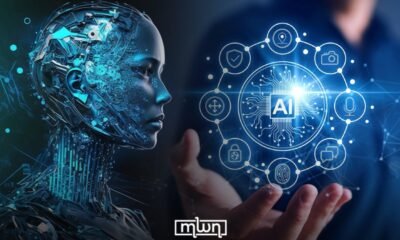AI Research
Should You Buy Palantir Technology Stock Before Aug. 4?

-
Palantir is taking the high ground in the artificial intelligence (AI) software revolution.
-
The company has delivered nine consecutive quarters of accelerating revenue and profit growth thanks to its state-of-the-art AI solutions, and shows no signs of slowing.
-
Its pricey valuation might send some investors packing, but its growth story will play out over the next decade.
The advent of artificial intelligence (AI) several years ago sparked a paradigm shift in technology that will likely continue for the next decade. Generative AI has the potential to streamline processes, increase productivity, and drive more profits to the bottom line. This has large and small businesses alike eager to join the AI revolution, but many simply don’t know how to get started.
Palantir Technologies (NASDAQ: PLTR) recognized the need and responded accordingly. The company developed a system designed to provide real-time, data-driven solutions while providing companies with a way to get started, and the results speak for themselves. The stock has gained 421% over the past year (as of this writing) and is up 1,890% since AI went viral in late 2022.
The company faces a key test with investors when Palantir reports its second-quarter results after the market close on Aug. 4. Given the stock’s blistering returns over the past year, should investors buy Palantir stock ahead of this crucial financial report, or wait until after the results have been made public? Let’s see what we can learn from the available evidence.
While generative AI has been all the rage over the past couple of years, Palantir has been developing data mining and AI solutions long before it became fashionable. The company worked in relative obscurity for years, designing AI-powered solutions for U.S. intelligence agencies and other federal departments.
After establishing itself as the gold standard for government AI solutions, Palantir turned its attention to corporate America and created a platform that could devise elegant solutions to everyday business problems. By connecting siloed business software systems through a central dashboard, Palantir created a system that provides data-driven intelligence and actionable insights. The company’s most recent brainchild, its Artificial Intelligence Platform (AIP), leverages company-specific information to craft custom solutions.
Many business executives are keen to benefit from the windfall of AI, but have no idea how to implement the appropriate systems. That’s where Palantir comes in. Business executives and developers are partnered with Palantir engineers to create solutions for their most pressing issues. “These immersive, hands-on sessions allow new and existing customers to build live alongside Palantir engineers, all working toward the common goal of deploying AI in operations,” Palantir said.
AI Research
How Traditional Search Engines Are Evolving

Generative artificial intelligence is not just improving search; it’s revolutionizing the entire concept of information retrieval.
Traditional search engines operated on a simple premise: match keywords to web pages, then rank results. This approach often left users frustrated, forcing them to refine queries multiple times or dig through numerous links to find specific information.
Generative AI has shattered this paradigm. Modern search platforms now interpret natural language queries with unprecedented sophistication. Instead of returning lists of links, they provide direct, contextual answers synthesized from multiple sources. Users can ask follow-up questions, request clarifications, or explore topics within the same conversation.
Consider the difference: searching “climate change Morocco agriculture” traditionally yields thousands of links. An AI-powered search engine provides an immediate, comprehensive overview of climate impacts on Moroccan agriculture, complete with specific data and regional variations – all while citing sources transparently.
The Technology Behind the Magic
Large language models (LLMs) trained on vast datasets enable machines to understand and generate human-like text. When integrated with real-time web crawling, they create “retrieval-augmented generation” (RAG) systems that combine internet knowledge with AI analysis. It’s like having a research assistant that instantly reads thousands of documents and provides tailored summaries.
Major Players Reshape the Landscape
Google has integrated AI into its core search through Search Generative Experience (SGE), essentially rebuilding search from the ground up. Microsoft’s ChatGPT integration transformed Bing from an also-ran to a legitimate competitor overnight. Meanwhile, new players like Perplexity AI have emerged as pure “AI answer engines,” bypassing traditional search entirely.
Impact on Users and Businesses
The benefits for users are transformative. Complex research tasks that once required hours now take minutes through conversational interactions. This democratization particularly benefits users in developing regions with limited digital literacy or bandwidth constraints.
For businesses, traditional SEO strategies focused on keywords are becoming obsolete. Success now requires creating authoritative, well-sourced content that AI systems can understand and cite. Companies must focus on becoming trusted information sources rather than gaming search algorithms.
Voice search capabilities have dramatically improved, making information accessible to users with disabilities or those in hands-free situations. Educational applications are equally impressive, with AI search engines serving as sophisticated tutoring systems.
Challenges and Concerns
Significant challenges remain. AI systems can generate confident-sounding but incorrect information – a phenomenon called “hallucination.” Privacy concerns arise as conversational search engines collect more detailed behavioral data than traditional keyword systems.
The concentration of AI capabilities among few major companies raises concerns about information diversity and potential bias. When a handful of AI models influence how billions access information, fairness and accuracy become critical issues.
The Future of Information Access
Emerging trends include multimodal search capabilities interpreting images, videos, and audio alongside text. Real-time integration promises search engines providing up-to-the-minute data on rapidly changing situations. IoT integration will enable contextual search considering your location, time, and current activity.
For the MENA region, including Morocco, this AI revolution presents unique opportunities. Local businesses creating high-quality, authoritative content in Arabic and French can gain unprecedented visibility in AI search results. The technology also addresses linguistic diversity challenges, as AI systems become sophisticated at handling multiple languages and cultural contexts.
As we stand at this inflection point, the blue link era is ending. The age of conversational AI search promises faster, more accurate, and more intuitive access to human knowledge than ever before. For users worldwide, this transformation represents not just technological progress, but a fundamental shift in how we interact with information itself.
AI Research
The Machine Learning Lessons I’ve Learned This Month

in machine learning are the same.
Coding, waiting for results, interpreting them, returning back to coding. Plus, some intermediate presentations of one’s progress. But, things mostly being the same does not mean that there’s nothing to learn. Quite on the contrary! Two to three years ago, I started a daily habit of writing down lessons that I learned from my ML work. In looking back through some of the lessons from this month, I found three practical lessons that stand out:
- Keep logging simple
- Use an experimental notebook
- Keep overnight runs in mind
Keep logging simple
For years, I used Weights & Biases (W&B)* as my go-to experiment logger. In fact, I have once been in the top 5% of all active users. The stats in below figure tell me that, at that time, I’ve trained close to 25000 models, used a cumulative 5000 hours of compute, and did more than 500 hyperparameter searches. I used it for papers, for big projects like weather prediction with large datasets, and for tracking countless small-scale experiments.
And W&B really is a great tool: if you want beautiful dashboards and are collaborating** with a team, W&B shines. And, until recently, while reconstructing data from trained neural networks, I ran multiple hyperparameter sweeps and W&B’s visualization capabilities were invaluable. I could directly compare reconstructions across runs.
But I realized that for most of my research projects, W&B was overkill. I rarely revisited individual runs, and once a project was done, the logs just sat there, and I did nothing with them ever after. When I then refactored the mentioned data reconstruction project, I thus explicitly removed the W&B integration. Not because anything was wrong with it, but because it wasn’t necessary.
Now, my setup is much simpler. I just log selected metrics to CSV and text files, writing directly to disk. For hyperparameter searches, I rely on Optuna. Not even the distributed version with a central server — just local Optuna, saving study states to a pickle file. If something crashes, I reload and continue. Pragmatic and sufficient (for my use cases).
The key insight here is this: logging is not the work. It’s a support system. Spending 99% of your time deciding on what you want to log — gradients? weights? distributions? and at which frequency? — can easily distract you from the actual research. For me, simple, local logging covers all needs, with minimal setup effort.
Maintain experimental lab notebooks
In December 1939, William Shockley wrote down an idea into his lab notebook: replace vacuum tubes with semiconductors. Roughly 20 years later, Shockley and two colleagues at Bell Labs were awarded Nobel Prizes for the invention of the modern transistor.
While most of us aren’t writing Nobel-worthy entries into our notebooks, we can still learn from the principle. Granted, in machine learning, our laboraties don’t have chemicals or test tubes, as we all envision when we think about a laboratory. Instead, our labs often are our computers; the same device that I use to write these lines has trained countless models over the years. And these labs are inherently portably, especially when we are developing remotely on high-performance compute clusters. Even better, thanks to highly-skilled administrative stuff, these clusters are running 24/7 — so there’s always time to run an experiment!
But, the question is, which experiment? Here, a former colleague introduced me to the idea of mainting a lab notebook, and lately I’ve returned to it in the simplest form possible. Before starting long-running experiments, I write down:
what I’m testing, and why I’m testing it.
Then, when I come back later — usually the next morning — I can immediately see which results are ready and what I had hoped to learn. It’s simple, but it changes the workflow. Instead of just “rerun until it works,” these dedicated experiments become part of a documented feedback loop. Failures are easier to interpret. Successes are easier to replicate.
Run experiments overnight
That’s a small, but painful lessons that I (re-)learned this month.
On a Friday evening, I discovered a bug that might affect my experiment results. I patched it and reran the experiments to validate. By Saturday morning, the runs had finished — but when I inspected the results, I realized I had forgotten to include a key ablation. Which meant … another full day of waiting.
In ML, overnight time is precious. For us programmers, it’s rest. For our experiments, it’s work. If we don’t have an experiment running while we sleep, we’re effectively wasting free compute cycles.
That doesn’t mean you should run experiments just for the sake of it. But whenever there is a meaningful one to launch, starting them in the evening is the perfect time. Clusters are often under-utilized and resources are more quickly available, and — most importantly — you will have results to analyse the next morning.
A simple trick is to plan this deliberately. As Cal Newport mentions in his book “Deep Work”, good workdays start the night before. If you know tomorrow’s tasks today, you can set up the right experiments in time.
* That ain’t bashing W&B (it would have been the same with, e.g., MLFlow), but rather asking users to evaluate what their project goals are, and then spend the majority of time on pursuing that goals with utmost focus.
** Footnote: mere collaborating is in my eyes not enough to warrant using such shared dashboards. You need to gain more insights from such shared tools than the time spent setting them up.
AI Research
How is artificial intelligence affecting job searches?

Artificial intelligence programs like ChatGPT use AI to do thinking or writing or creating for you. Pretty amazing, but also a little terrifying. What happens to the people who used to do those jobs?
Olivia Fair graduated four years ago. “I’ve applied to probably over a hundred jobs in the past, I don’t know, six months,” she said. “And yeah, none of them are landing.”
She’s had a series of short-term jobs – one was in TV production, transcribing interviews. “But now they don’t have a bunch of people transcribing,” she said. “They have maybe one person overseeing all of that, and AI doing the rest. Which I think is true for a lot of entry-level positions. And it can be a very useful tool for those people doing that work. But then there’s less people needed.”
According to Laura Ullrich, director of economic research at Indeed, the job-listings website, job postings have declined year over year by 6.7 percent. “This is a tough year,” she said. “Younger job seekers, specifically those who are recent grads, are having a harder time finding work.”
Asked if there is a correlation between the rise in AI and the decline in jobs for recent graduates, Ullrich said, “I think there is a cause-and-effect, but it’s maybe not as significant as a lot of people would think. If you look specifically at tech jobs, job postings are down 36% compared to pre-pandemic numbers. But that decline started happening prior to AI becoming commonly used.”
Ullrich said in 2021-22, as the effects of the COVID pandemic began to ebb, there was a hiring boom in some sectors, including tech: “Quite frankly, I think some companies overhired,” she said.
The uncertain national situation (tariffs, taxes, foreign policy) doesn’t help, either. Ullrich said, “Some other people have used the analogy of, like, driving through fog. If it’s foggy, you slow down a bit. But if it’s really foggy, you pull over. And unfortunately, some companies have pulled over to sit and wait to see what is gonna happen.”
That sounds a little more nuanced than some recent headlines, which make it pretty clear that AI is taking jobs:
“I read today an interview with a guy who said, you know, ‘By 2027, we will be jobless, lonely, crime on the streets,'” said David Autor, a labor economist at MIT. “And I said, ‘How do I take the other side of that bet?’ ‘Cause that’s just not true. I’m sure of that. My view is, look, there is great potential and great risk. I think that it’s not nearly as imminent on either direction as most people think.”
I said, “But what it does seem to do is relieve the newcomers, the beginning, incoming novices we don’t need anymore.”
“This is really a concern,” Autor said. “Judgment, expertise, it’s acquired slowly. It’s a product of immersion, right? You know, how do I care for this patient, or land this plane, or remodel this building? And it’s possible that we could strip out so much of the supporting work, that people never get the expertise. I don’t think it’s an insurmountable concern. But we shouldn’t take for granted that it will solve itself.”
Let’s cut to the chase. What are the jobs we’re going to lose? Laura Ullrich said, “We analyzed 2,800 specific skills, and 30% of them could be, at least partially, done by AI.” (Which means, 70% of job skills are not currently at risk of AI.)
So, which jobs will AI be likely to take first? Most of it is jobs in front of a screen:
- Coding
- Accounting
- Copy writing
- Translation
- Customer service
- Paralegal work
- Illustration
- Graphic design
- Songwriting
- Information management
As David Autor puts it: “What will market demand be for this thing? How much should we order? How much should we keep in stock?”
AI will have a much harder time taking jobs requiring empathy, creative thinking, or physicality:
- Healthcare
- Teaching
- Social assistance
- Mental health
- Police and fire
- Engineering
- Construction
- Wind and solar
- Tourism
- Trades (like plumbing and electrical)
And don’t forget about the new job categories that AI will create. According to Autor, “A lot of the work that we do is in things that we just didn’t do, you know, 50 or 100 years ago – all this work in solar and wind generation, all types of medical specialties that were unthinkable.”
I asked, “You can’t sit here and tell me what the new fields and jobs will be?”
“No. We’re bad at predicting where new work will appear, what skills it will need, how much there will be,” Autor said, adding, “There will be new things, absolutely.”
“So, it sounds like you don’t think we are headed to becoming a nation of people who cannot find any work, who spend the day on the couch watching Netflix?”
Autor said, “No, I don’t see that. Of course, people will be displaced, certain types of occupations will disappear. People will lose careers. That’s going to happen. But we might actually get much better at medicine. We might figure out a way to generate energy more cheaply and with less pollution. We might figure out a better way to do agriculture that isn’t land-intensive and so ecologically intensive.”
Whatever is going to happen, will likely take a while to happen. The latest headlines look like these:
Until then, Laura Ullrich has some advice for young job seekers: “The number one piece of advice I would give is, move forward. So, whether that is getting another job, getting a part-time job, finding a post-graduate internship – reach out to the professors that you had. They have a whole network of former students, right? Reach out to other alumni who graduated from the school you went to, or majored in the same thing you majored in. It might be what gets you a job this year.”
So far, Olivia Fair is doing all of the above. I asked her, “You’re interested in creativity and writing and production. So let me hear, as a human, your pitch, why you’d be better than AI doing those jobs?”
“Okay,” Fair replied. “Hmm. I’m a person, and not a robot?”
For more info:
Story produced by Gabriel Falcon. Editor: Chad Cardin.
See also:
-
Tools & Platforms3 weeks ago
Building Trust in Military AI Starts with Opening the Black Box – War on the Rocks
-

 Ethics & Policy1 month ago
Ethics & Policy1 month agoSDAIA Supports Saudi Arabia’s Leadership in Shaping Global AI Ethics, Policy, and Research – وكالة الأنباء السعودية
-

 Business2 days ago
Business2 days agoThe Guardian view on Trump and the Fed: independence is no substitute for accountability | Editorial
-

 Events & Conferences3 months ago
Events & Conferences3 months agoJourney to 1000 models: Scaling Instagram’s recommendation system
-

 Jobs & Careers2 months ago
Jobs & Careers2 months agoMumbai-based Perplexity Alternative Has 60k+ Users Without Funding
-

 Funding & Business2 months ago
Funding & Business2 months agoKayak and Expedia race to build AI travel agents that turn social posts into itineraries
-

 Education2 months ago
Education2 months agoVEX Robotics launches AI-powered classroom robotics system
-

 Podcasts & Talks2 months ago
Podcasts & Talks2 months agoHappy 4th of July! 🎆 Made with Veo 3 in Gemini
-

 Podcasts & Talks2 months ago
Podcasts & Talks2 months agoOpenAI 🤝 @teamganassi
-

 Jobs & Careers2 months ago
Jobs & Careers2 months agoAstrophel Aerospace Raises ₹6.84 Crore to Build Reusable Launch Vehicle



















